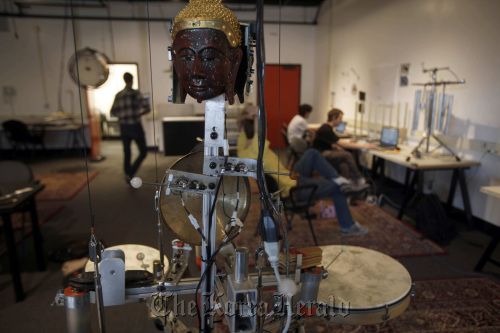LOS ANGELES ― Ajay Kapur and Michael Darling have glimpsed the future. And it looks a little like “The Jetsons” meets “Spinal Tap.”
In the not-too-distant future, they say, stadium concerts as we know them will be passe. In their place, humans will jam onstage with hipster robots that will perform previously unheard sounds during mind-blowing multimedia shows that are three-dimensional, interactive soundscapes. Seats will swivel; miniature ‘bots will fly through the air; sound-activated animation will dance overhead and enormous, hanging fiberglass embryos will glow and change color with the music.
In the not-too-distant future, they say, stadium concerts as we know them will be passe. In their place, humans will jam onstage with hipster robots that will perform previously unheard sounds during mind-blowing multimedia shows that are three-dimensional, interactive soundscapes. Seats will swivel; miniature ‘bots will fly through the air; sound-activated animation will dance overhead and enormous, hanging fiberglass embryos will glow and change color with the music.

Year 2015? 2050? The robotics instructors say more like two weeks from now.
Kapur and Darling, head of California Institute of the Arts’ music technology and theatrical technical direction departments, respectively, have combined students and teaching resources to create a cutting-edge robot orchestra programmed for improvisation to jam with humans. The futuristic endeavor ― called KarmetiK Machine Orchestra (after karma and kinetic) ― combines elements of artificial intelligence/robotics, electronic music and theater. It features nine “robot instruments,” designed and built by students who play with them via customized computerized interfaces. The orchestra will perform a mix of world fusion, modern electronic, experimental, groove-oriented beats and Indian classical music during an immersive audio-visual installation concert on May 12.
“It’s about new ways of making noise,” Darling says. “There’s things you can do with them that humans can’t do.” Adds Kapur: “It’s about how humans and machines work together, onstage, to actually create a sonic and visual experience for the audience. How you do that in an organic way. That’s really what we’ve been exploring.”
Performing robots aren’t exactly new ― Kapur cites German sculptor and sound artist Trimpin as “the godfather of this sort of thing,” and he says Trimpin and Eric Singer, director of the New York-based League of Electronic Musical Urban Robots, are his mentors. But Kapur stresses that the KarmetiK Machine Orchestra is taking things in new, groundbreaking directions in terms of its size, large scale of its performances and degree of interactivity between robots and humans.
For all its performance bling and potential in the field of robotics research, however, teaching remains at the heart of the Machine Orchestra. It’s a way for Kapur and Darling to trick students with an arts bent into learning science, technology, engineering and math ― skills both instructors believe are essential for musicians in today’s digital entertainment landscape, especially electronic musicians.
A visit to the Machine Orchestra’s new on-campus robotics lab is both a visual and sonic treat ― in a “Frankenstein goes to his first rave” kind of way. Ten or so artsy-looking music students bang, tap and tweak giant, industrial-looking robot instruments spaced around the room and hanging from a grid on the ceiling. Open laptops are perched everywhere; a tangle of wires, cables and cords snakes across the floor. The sudden boom of a base drum or the piercing clang of cymbals sets off a flash of neon on an overhead screen.
Yet when the robots play all at once, producing what can be described only as “melodic noise,” there’s an inherent cohesion. Each Bot has a distinct personality and a musical place in the orchestra. There’s Maha-Devi Bot, the first robot built by Kapur in 2005 as part of his masters thesis, “Digitizing North Indian Music.” It’s a two-headed, 12-armed percussion robot adorned with Himalayan bells, an Indian tambourine and circuit board strips, among other things. It hangs from the ceiling, suspended in midair, like a hovering, long-legged spider.
Gana-Pati Bot, with its Hindu god-like elephant head and body of small percussion instruments, was the first project between Kapur and Darling when they began collaborating three years ago. And Tammy, a tall, regal-looking vertical marimba with hand-cut, hand-tuned rosewood blocks and a steel Cyclops eye for a head, was the first student project. Raina, a pink noise-making rain stick filled with lentils and running off a 90-volt DC motor, is mellow and seemingly shy; whereas String Thing, made of skateboard wheels, steel rods and inspired by a slide guitar, is more panicky and nervous-sounding.
“How we’re trying to turn them into characters is a big goal,” Kapur says. “We’re moving towards a play in the next year.”
Darling, who has a background in fine art and sculpture and whose students build the robots in the scene shop, says he took his aesthetic inspiration from, among other things, “Battlestar Galactica” and ’70s sci-fi movies. “I like the things to look like they’re eating themselves ― all the mechanics have to show,” he says.
The grassroots aspect of the Machine Orchestra is central to its identity, says Darling. Robots are made from whatever reused materials students can scrape together: scrap metal from theatrical productions, trash cans or discarded printer parts, a random bell from inside a telephone.
By Deborah Vankin
(Los Angeles Times)
(McClatchy-Tribune Information Services)











![[Today’s K-pop] BTS pop-up event to come to Seoul](http://res.heraldm.com/phpwas/restmb_idxmake.php?idx=644&simg=/content/image/2024/04/17/20240417050734_0.jpg&u=)




![[KH Explains] Hyundai's full hybrid edge to pay off amid slow transition to pure EVs](http://res.heraldm.com/phpwas/restmb_idxmake.php?idx=652&simg=/content/image/2024/04/18/20240418050645_0.jpg&u=20240418181020)

![[Today’s K-pop] Zico drops snippet of collaboration with Jennie](http://res.heraldm.com/phpwas/restmb_idxmake.php?idx=642&simg=/content/image/2024/04/18/20240418050702_0.jpg&u=)